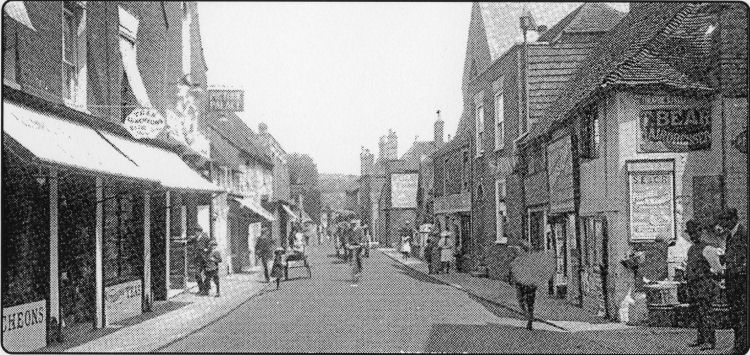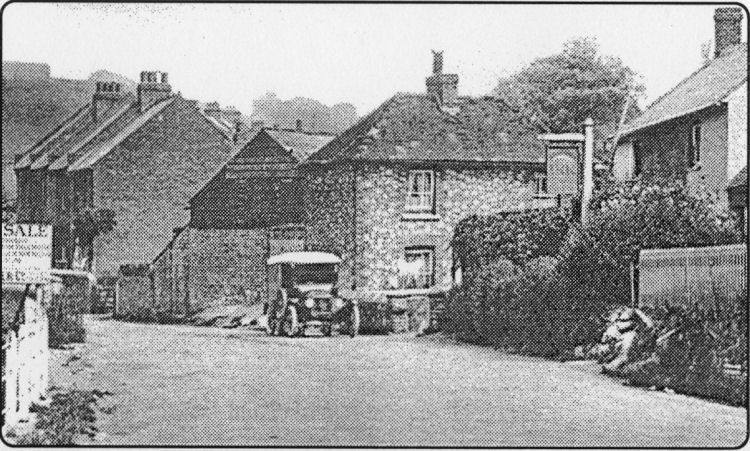
Published 9 January 2003


A LOCAL clergyman friend of mine, whose wife went to St Margaret's School
in Folkestone in the fifties, is wondering if any Memories reader can tell
him what happened to the photographic negatives of the former Folkestone
firm of photographers, Lambert & Weston Ltd. Alternatively perhaps there are
readers who have photographs taken at stage productions, particularly
pantomimes performed in the early 1950s by girls of St Margaret's School -
such as "Cinderella" and "Dick Whittington and his Cat." If anyone can help
please contact the Rev Ted Allright, on 01304 813040.
ONE OF the famous Cinque Ports, even though it is now but an inland town,
Hythe can look back on a long and illustrious history and we are fortunate
that a host of photographs, picture postcards and engravings, as well as
books and manuscripts, record its fascinating past.
Hundreds of these pictures must have been studied by two local enthusiasts,
Martin Easdown and Linda Sage before making a final selection for inclusion
in the excellent hardback pocket book they have compiled during the past
year for publication by Dutch publishers.
European Library's "Hythe in oid Picture Postcards," now on sale, is the
latest in their "Back in Time" series of books highlighting the past seen
through the eyes of photographers and publishers who have produced postcards
over the past century.
Thomas a Becket killers
Martin and Linda, who have co-operated in producing a number of paperback
books on local subjects, had the task of whittling down the number of
illustrations to 76 and writing informative captions and I think readers
will agree the result is a most interesting and worthwhile addition to books
already in print on our local history.
The writers have incorporated such a varied selection of pictures of
Seabrook that the title of the book might well have reflected this.
The writers tell briefly how the four knights who murdered Thomas a Becket
in Canterbury Cathedral landed at Hythe in 1170 and met at Saltwood Castle
before the brutal killing.
They relate how the town became something of a quiet backwater after its
harbour silted up, but then began to grow in importance again as invasion
was threatened by Napoleon and both the Hythe Royal Military Canal - now
listed as an ancient monument
— and a unique chain of Martello Towers, were built.
Hythe became a military base with a school of musketry boosting employment
and prosperity and then the coming of the railway to the district saw the
town boom with development and become a select seaside resort, boasting such
attractions as a horse-drawn tramway service, golf course and later, the
Romney, Hythe & Dymchurch Light Railway.
Seabrook harbour plan
The eastern end of the Royal Military Canal is at Seabrook where hopes were
raised at one time by a big housing and resort scheme, including a pleasure
pier and, the authors reveal, by a plan to build a great harbour at this
sheltered spot.
The Seabrook development scheme was frustrated, however, by the railway
company's eventual decision not to extend the old Hythe branch line from
Seabrook to Folkestone harbour.
The pier was never built and neither was the new harbour. Sadly Sandgate
station closed in 1931 and then Hythe lost its main line station, in 1951,
leaving Sandling as the nearest for rail travellers.
One interesting old postcard illustrated in the book reflects the town's
one-time links with smuggling gangs of the 19th Century - a picture of the
"Smugglers' Retreat" in the centre of Hythe High Street, dating from 1905.
A tower at the top of the building was reputed to have housed a lantern to
signal to smugglers at sea.
Sadly, as happens all too often, the interesting building, divided into
shops, was allowed to fall into disrepair and was demolished in 1908.
Another interesting property pictured with a story to tell, is the old
Lifeboat House, built of Kentish ragstone, which stood near the former
Seabrook Police Station. Latterly the Boathouse Cafe, it was pulled down in
1956.
The Lifeboat House, nicknamed the "Goose
A 90 year old scene in Hythe High Street with the old Picture Palace on the
left and the shop of Davis & Davis on the corner of Theatre Street, on the
right. The heyday of the Picture Palace was during the First World War when
many Canadian soldiers were based in the area. BELOW: A rural scene in Horn
Street, Seabrook about 80 years ago with the Britannia Inn on
the right which faced the old Horn Street Mill which was behind the sale
sign on the left.
Cathedral," was immortalised in a book of the same name by local-born author
Jocelyn Brooke.
It had been built in 1875 to house the Hythe (Seabrook) station lifeboat
"Meyer de Rothschild' but was replaced in 1893 by two stations, one nearer
Hythe and the other Folkestone, after difficulty experienced in launching
the lifeboat when the sailing ship Benvenue was wrecked about two years
earlier.
Hythe in old Picture Postcards is priced at £9.95.
Good read
 |
Hotel at centre of row over Leas'palisade’eyesore
«• qaqA CHRISTMAS - New Year sensation X9vwwas a monstrous wooden paling
fence, five or six feet high on the Leas. This was erected on the inside
edge of the Leas, from a fence which was the western boundary of a
football ground, down to a fence in front of the Manor House, This cut
off access to the Leas from the newly built Hotel Metropole and
adjoining streets. In addition strands of barbed wire had been used to
strengthen fencing at the east end of the recreation ground to hinder
access in that direction. This was all to do with a dispute between
Gordon Hotels Ltd and the trustees of Lord Radnor's estate company.
Apart from denying guests of their palatial hotel easy access to the
famous Leas promenade it cut off the hotel from the bandstand it had
generously presented to the town. Herald had a report and a picture of a
"Dolter Surface Contact System' tramcar some hoped would be used in
Folkestone to operate a public tramway service. It picked up the
electric current from the tram track itself instead of from a system of
overhead wires which seemed such an objectionable idea to one vociferous
faction of the local community.
|
Shakespeare - and motor rally plans for Coronation
a QCQFOLKESTONE and Hythe Operatic and -LJ/OODramatic Society
volunteered to organise an open air Shakespearian production as part of
the district's Coronation celebrations and the Folkestone Motor Cycle
Club was organising a motorcycle gymkhana, while the Folkestone Motor
Trade Committee was to hold a Treasure Hunt as well as offering to
present a Concours d'Elegance motor show with eight main classes,
including one for vintage cars. Many other local events were planned
including an inter-club sports meeting organised by Folkestone Athletic
Club and an inter-club swimming gala was to be held by Folkestone
Swimming Club in collaboration with Folkestone Bathing Co Ltd, at the
Bathing Pool. In Hythe road safety was a talking point among
councillors, one of whom told of the danger of lorries overhanging
narrow pavements, with the risk of hitting pedestrians, where there was
a steep camber in High Street. And yet, he said, although the subject
had been raised a number of times nothing was ever done about it. It was
being suggested pedestrians should always walk along a pavement facing
oncoming traffic in narrow sections of the street.
|
Herald'm action demand to revive ferry trade at port
qaqHERALD writer Felix was calling for JL5/<£©the Town Council and
Chamber of Commerce to unite in a push to persuade the railway
authorities to start another cargo ferry service between Folkestone and
Boulogne to help make up for the unemployment and Toss of trade to local
shops ana other businesses caused by the switching of the Flushing
service from the port to Harwich. Felix, who said he was reflecting the
wishes of a significant number of townspeople, also suggested attention
be given to repairing iron fencing along the cliff edge opposite Priory
Gardens, where there was a risk of children toppling over to their
deaths. Looking back half a century Felix told how the New Year seemed
to herald the arrival of a spell of "wild weather." In 1877 serious
damage was caused by a storm which dislodged massive blocks of concrete
and stone and nearly destroyed a newly-built pier. The Marine Parade and
Marine Crescent were invaded by the sea and a thanksgiving service was
held at St Peter's Church after three narrow escapes by local fishing
boats which were driven round the pierhead.
|
Local fears over meetings planned by National Front
•I ALLEGATIONS that a religious orgatv
■L%7 / Oisation was being used as a cover-up for National Front meetings
in Folkestone were strongly: denied. Denials came after a hotelier
cancelled 10 meetings due to be held of the local branch of the British
Israel World Federation.: It was he who feared a cover-up, although his
inquiries had revealed that the Federation itself was genuine enough.
Eric Segal, 28, owner of the Springfield Hotel, in Westbourne Gardens,
said the person who approached him was said to be on the books of the
National Front and one of the speakers was Kenneth McKilliam,
prospective National Front candidate for Ashford. Labour Party organiser
for Dover and Deal Mr Ian McCartney - later a Labour MP - told the
Herald he had no doubt the National Front was trying to book local
hotels and warned hoteliers to be vigilant. Shepway District Council
decided not to grant a full time appointment to promotional consultant
Leonard Piper completing a one-year assignment to help sell industry ana
commerce in the district. He was good at the job but it was feared by
some his full time appointment at Folkestone would have meant the
shedding of other staff. |
|



